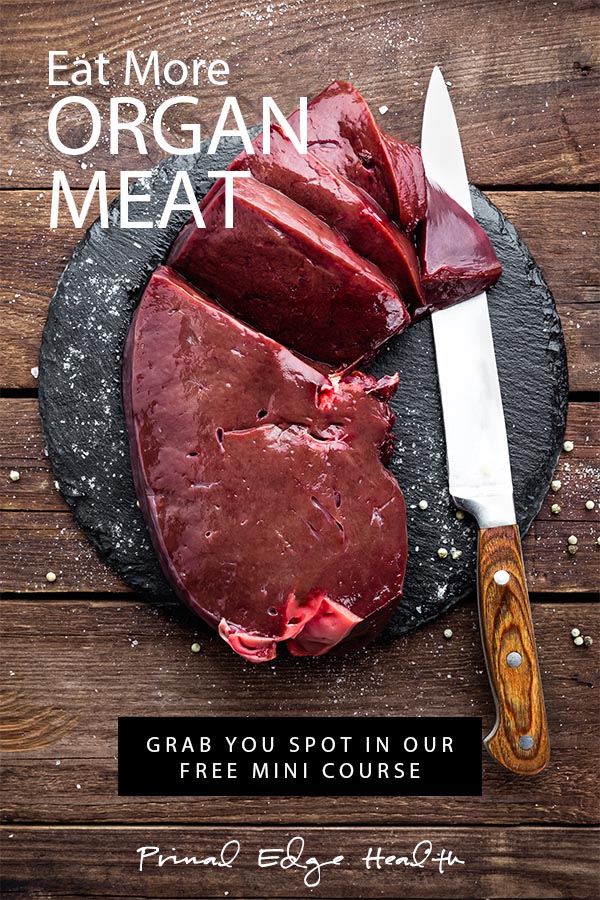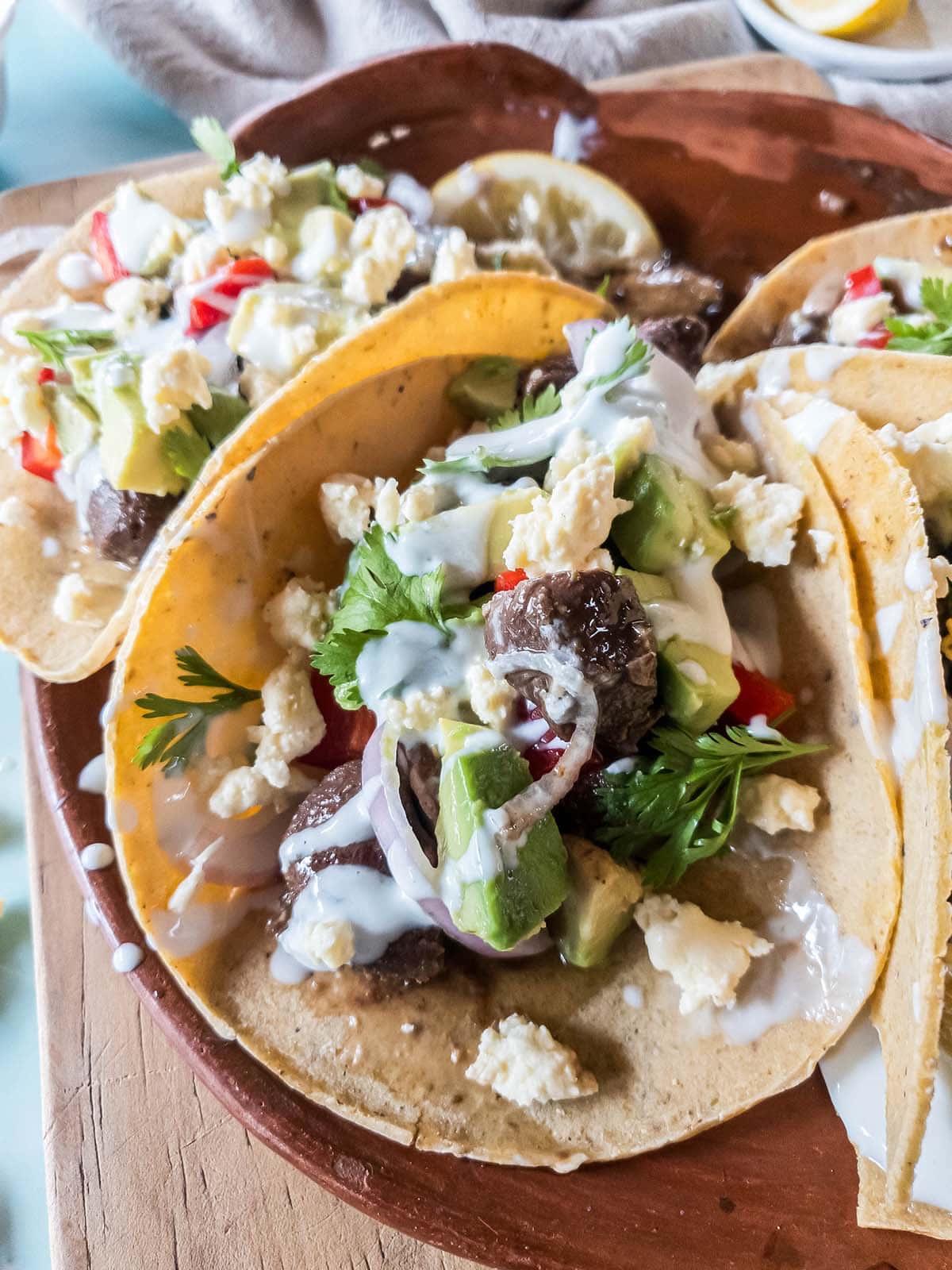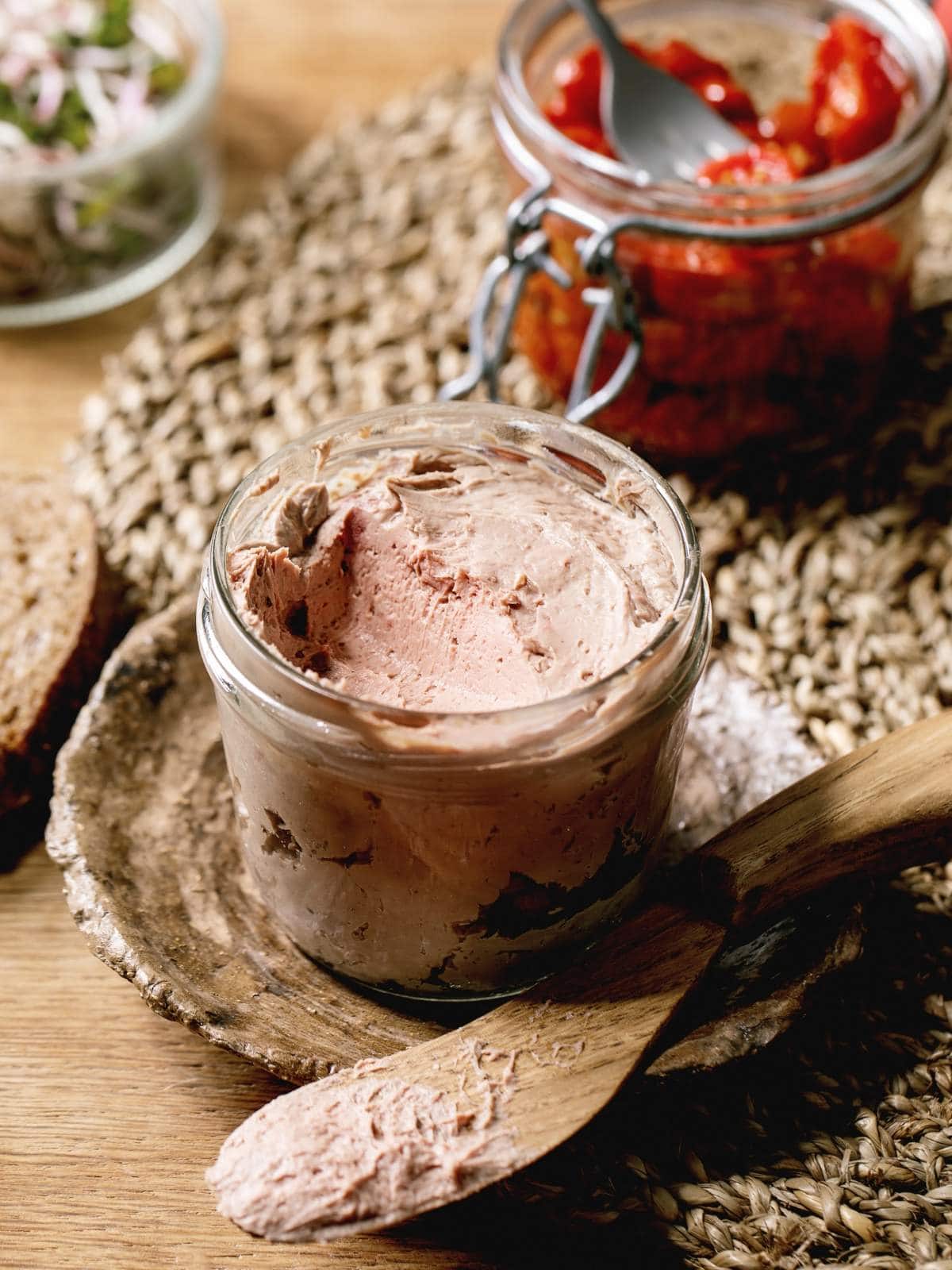How to Cook Organ Meat Recipes you Actually Want to Eat
Primal Edge Health participates in the Amazon Services LLC Associates Program and other affiliate programs and therefore, may collect a share of sales or other compensation from the links on this page. This comes at no additional cost to you, and all the prices and availability are accurate at the time of publishing.
Are you ready to learn how to cook organ meat recipes that give all the great benefits of nose-to-tail eating, help save money on your grocery bill, and actually taste delicious? It can be done! Nose-to-tail eating is a practical, budget-friendly, and enjoyable way of eating organ meats.

I am thrilled to see interest in organ meat recipes continue to rise. After blogging about the health benefits of organ meats and the impressive nutritional benefits of liver for so many years, it’s very exciting to meet more and more people interested in this way of eating.
It’s not for everyone, but chances are, if you are here reading this post, you are ready to try it out for yourself. So, here are the best recipes you can start with.
Table of Contents (click to view)
What is the Best Organ Meat to Eat?
Thanks to the popularity of paleo, the keto diet, and the carnivore diet, liver is the most popular and well-known organ meat. However, truth be told, any organ you can source, cook, and enjoy is the “best” one for you to eat! The most common types of organ meat are:
- Liver
- Heart
- Kidney
- Sweetbreads
- Tongue
Beef, lamb, mutton, goat, bison, elk, deer, chicken, duck, goose, and pork all have delicious organs to eat! Take a deeper dive into beef liver vs. chicken liver and give each a taste test to find your favorite.
Source grass-fed, pasture-raised, and organic organ meats over conventionally raised whenever possible. These are higher in nutrients like omega-3s and vitamins, making them a healthier choice. Plus, they’re raised with fewer pesticides and antibiotics, which means less exposure to toxins. Using the tips in this guide on how to buy liver will help you source liver and also other organ meats.
Pro tip: Check out your local butcher if they sell organ meats. If you live in an agricultural area, connect with local food producers to see if they sell organ meats in bulk. Going straight to the source is the best way to get the freshest organ meat possible, and buying in bulk can save you a bit of money.
More advanced recipes with tongue, sweetbreads, brain, tripe, trotters, pancreas, hooves, and bone marrow are found in my cookbooks. They might seem off-putting at first, but they’re very much worth trying at least once! Exploring unusual organ meats also means the whole animal goes to good use.
How Do You Start Eating Organ Meat?
Thanks to the modern food system, most of us are completely removed from knowing where food really comes from. After growing up and only eating, seeing, and tasting muscle meats, tip-to-tail parts are relatively foreign.
Obviously, this is cultural programming and just because we don’t know about something, doesn’t mean it is necessarily bad or gross. It might just be misunderstood!
Start with an open mindset
The biggest hurdle to starting with eating more organ meats is a mental one. You have to want to do it. No one goes out and accidentally eats a lamb kidney.
Given the opportunity tastes, gut bacteria, and cravings will change. Over time, you get more accustomed to organ meat recipes and enjoy them more and more.
We all know steaks are great but don’t stop there! Organ meats are highly nutritious, easily digested foods given to us to build our bodies, boost our immune systems, and nourish our brains. They can be nutrient-packed occasional meals for the whole family, even your dog!
Learn How to Eat Organ Meat that isn’t Gross!
I developed a free email mini-course that will introduce you to the most common organ meats and teach you how to properly prepare them with ease and pleasure. You will learn my secrets to making nose-to-tail eating enjoyable, accessible, and practical for your diet and lifestyle.
My recipes are all low-carb, keto, carnivore, whole30, GAPS, and paleo-friendly. Consider them “template” recipes. They are very elemental, teaching all the necessary steps. Upon mastery, if you feel like improvising with other herbs and spices or additional sauces and dips, you certainly may.
How to Cook with All Parts of the Animal
Mixing ground organs into ground meat is the easiest way to get them in your body. For beginners, I recommend introducing organ meats with “disguised” organ meat recipes.
I share my favorite hidden organ meat recipes in the email series. These are tried and true recipes I feed my family multiple times a month. Be sure to sign up by clicking the banner above and learn my secrets to making organ meat recipes you actually want to eat!
Pick your favorite burger, meatball, or meatloaf recipe and add in a ground organ meat mix of liver, kidney, and heart. You already like the texture and consistency of the recipe, I bet you’ll barely notice any change in flavor.
Ground Meat Recipes with Hidden Offal
- Hidden Liver Meat Muffins (keto, carnivore, dairy-free)
- Low-Carb Cabbage Noodles and Liver (keto)
- Burgers with Hidden Beef Heart (keto, carnivore)
- Curry Lamb Meatballs (keto)
- Ultimate Beef and Liver Chili (part of an epic round-up of 99+ other offal recipes)
Master the basics of hiding ground meat and then you’ll be ready for more advanced recipes like my Organ Meat Stew. No need to follow all the instructions down to a T. If you want to skip or modify a certain step to make organ meats more palatable, feel free to do so!
When taking a whole organ, the simplest way to prepare offal is by baking, sautéing, pan-frying, or boiling. These are simple processes that are completed in just a few steps and don’t call for any fancy ingredients.
Bone Broth
Bone broth is a nutrient-rich, flavorful liquid made by simmering animal bones and connective tissues for an extended period, usually 12 to 24 hours. It’s a fantastic starting point if you’re new to organ meats, as it uses parts like marrow, cartilage, and even bits of organ meat for added nutrition.
Plus, it’s a great way to use the whole animal and make the most of every part while creating a delicious, comforting base for soups, stews, or just sipping on its own. Here’s an easy bone broth recipe you can make with a slow cooker.
What do Organ Meat Recipes Taste Like?
Each organ has its own flavor. Said to be “rich,” “earthy,” and “strong.” It is hard to pin down the exact flavor.
Each recipe varies due to the parts used and how they are prepared. Grilling will be different than boiling, which will be different from pan-frying. Do each of these cooking processes with a tomato and you’ll know exactly what I mean.
Of course, herbs (parsley, rosemary, thyme) and spices (ginger, cinnamon, allspice, garlic, onion, curry, hot pepper) also do quite a bit to mask any unusual taste. I provide simple, “template” recipes. You are welcome to add whatever additional flavoring agents you like. When in doubt, add more hot sauce.
All jokes aside, you have nothing to worry about and don’t even have to close your eyes because there’s nothing too odd staring back at you on the plate. If you’re not that keen on the taste of pure organ meat, throw it into the food processor with muscle meat to balance out the flavors.
Liver pate is an excellent recipe for beginners. Read all you need to know about liver pate and get started today!
Best Organ Meat Recipes for Beginners
Now that’s all said and done, what are the best dishes to try if you’re just starting out? Lucky for you, I’ve compiled some of my best organ meat recipes that are beginner-friendly:

Organ Meat Recipes from Around the World
From the USA to Mexico to Spain to England to China to Indonesia and everywhere in between, organ meats are on the menu. These are some of the most popular recipes from cultures around the world.
- Chicken Feet Adobo is a healthy low-carb Asian snack to nibble on. This simple recipe consists of fried chicken feet, garlic, Thai chili peppers, and a rich adobo sauce made with soy sauce.
- Haggis a famous Scottish preparation similar to black pudding in texture, made out of lamb or sheep’s offal (lung, liver, heart), spices, onions, and suet, and cooked in the animal’s stomach.
- Faggots is an old-fashioned British food made from pork belly and offal (liver, lungs, and heart) and caul fat from Great Britain.
- Chitterlings are a classic southern soul food made from the intestines of a pig, boiled down, fried up, and served with apple cider vinegar and hot sauce from the U.S.A.
- Menudo is an aromatic Mexican soup made of tripe, hominy, and chili, and is stewed for hours with garlic and other spices.
- Smalahove is a Western Norwegian traditional dish made from a sheep’s head, originally eaten before Christmas.
- Sarapatel pork viscera (tongue, lungs, liver, heart) fried in lard and spice, then simmered in blood until the sauce is thick. Varying by region, you may find it with tripe or without the heart and with the trachea instead. It may also be made from sheep or goats rather than pork. Originally brought by Portuguese colonists, it is popular in Northeastern Brazil and Goa, India.
- Lengua is a popular dish in Filipino and Latin American cuisine made from pork or beef tongue. The tongue is typically braised or slow-cooked until tender, then sliced and served in a rich, creamy sauce, often flavored with garlic, shallots, and mushrooms.
How Much Organ Meat Should I Eat?
The answer to this question really depends on you. There is no “one way” to eating organ meats. Nose-to-tail eating is now normalized in our family and I work liver, heart, and kidney in my weekly keto meal plan pretty effortlessly.
If you are just getting started, you might have one new dish every week for a few weeks. As your confidence grows you will be more comfortable with the handling of parts, cooking, and overall concept as a whole. Some people notice intense cravings for a certain part, this may or may not correlate to a specific nutrient deficiency that is remedied by eating that food.
A common concern about eating too much liver is the possibility of overdosing on Vitamin A. This simply is not the case. Studies that indicate toxicity were examining the isolated, synthetic form of Vitamin A, not the naturally occurring Vitamin A form. While the Vitamin A saga may be a lengthy one, the bottom line is that synthetic and natural Vitamin A do not act the same in the body.
There is minimal risk when it comes to increasing the consumption of organ meat. Eating intuitively, or as much as you like is usually a safe approach. However, make sure to consult a doctor if you have any conditions to be worried about, particularly gout, heart disease, or a condition that requires you to be on a low-protein diet.
Nevertheless, organ meats are a rich source of protein, vitamins, and minerals. It’s particularly dense in fat-soluble vitamins (Vitamins A, D, E, and K), and minerals like heme iron, zinc, and folate.
Can you Freeze Organ Meat Recipes?
Yes! You can freeze all the recipes shared in the email lessons. If you’re worried about organ meat overload, portion out servings and freeze them for the days and weeks to come.
A good example of this practice is to divide a batch of liver pate into smaller portions and freeze to last throughout the month. Freezing ice cube trays of pate will create individual servings that are easy to pop out whenever desired.
All the recipes I share are simple, modern dishes to be served on the side of the main entrée or as the featured portion themselves. Each recipe is excellent for weekly meal planning. They may be doubled or tripled, divided, and then refrigerated or frozen for easy meal prep.
Try an Organ Meat Recipe Today!
Incorporating organ meats into your diet doesn’t have to be complicated or intimidating. With these simple and tasty recipes, you can enjoy the incredible nutritional benefits of nose-to-tail eating while saving money on your grocery bill. Start small, experiment with different dishes, and don’t forget to consult with your doctor if needed.









You know for those of us that grew up in the 70’s and earlier, liver was a staple at least 2 times a week. It was cheap and easy to cook. My mom used to coat it a four salt and pepper mix then fry in bacon fat (back then bacon didn’t have the God like status it does today so it was also cheap) with onions of course. Kidneys a few times a month as well.
Finding fresh liver has been hard, it’s all pre-packaged frozen.
UNTIL my daughter took me to an Asian market close to her home north of Detroit. FRESH organ meat from cows, pigs, lamb, chickens….and all less than a dollar a pound. I bought several pounds, cooked some up fresh I skipped the flour and bacon, used Cajun spices (unreal the difference) and vacuum packed the rest.
What a great find in your area! Mexican grocers are also known to offer organ meats and odd bits. You can’t beat that price, less than a dollar per pound – WOW! Thanks for sharing your success with us Don.
I actually love chicken livers, as long as they are cooked with bacon. Beef liver isn’t my favorite thing, but I can (and do) eat it from time to time. I really haven’t ventured out any further than that. Definitely want to try heart, although I wish someone would just cook it for me!
When I was little my hair took MUCH longer to come in than was typical (I still hadn’t had a haircut in second grade, and my hair was about an inch long).
My parents asked my pediatrician about it and he recommended upping my iron by means of liver and spinach. I was a super picky eater as a kid, but my mom told me that if I ate liver and spinach my hair would grow, and I ate it!
To this day, pan-fried liver is one of my all-time favorite foods. I’m not sure if it helped my hair, but it did manage to make me a life-long organ mean lover!
What an amazing story! Thanks so much for sharing your experience <3
This type of cooking is not something I’ve ever attempted but it sure is *food* for thought!
It sure is 🙂 Thanks for checking it out!
I’m from South Louisiana. We grew up eating organ meat in different dishes. Two main dishes we eat organ meat in are boudin and dirty rice. Boudin traditionally has organ meat in it, but not all newer boudin places make it that way. You can really taste the difference!
This is so interesting to hear! I like learning about all the different offal dishes from around the world. Thanks for sharing 🙂